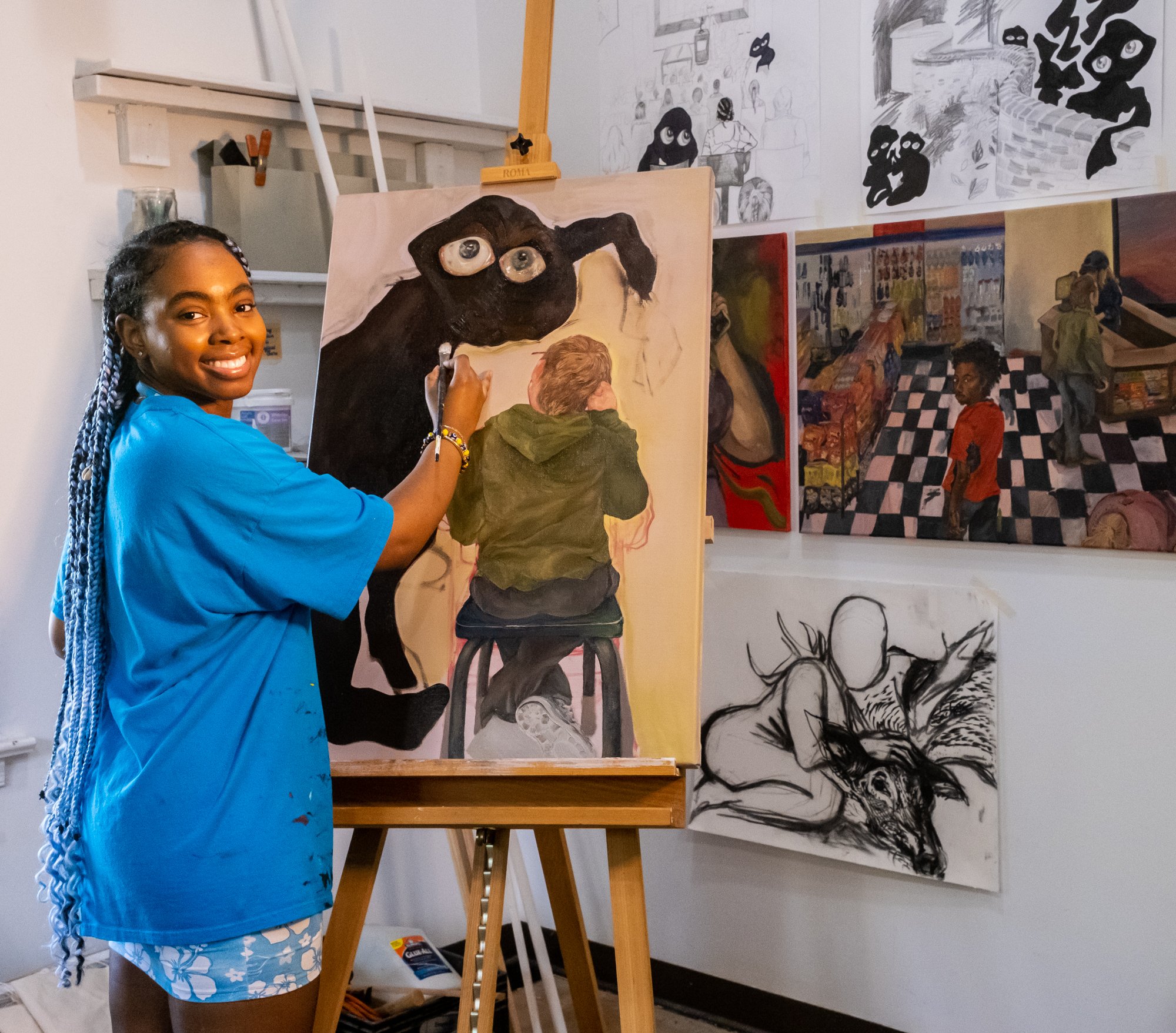7x7x7 Series: JaVori Warren
Painter JaVori Warren is the second featured artist in our sixth 7x7x7 Series, which asks 7 questions to 7 Charlottesville artists and is published once a week for 7 weeks. Artist interviews and studio visits were conducted by our summer intern, Kalista Diamantopoulos. Photos were taken by Benita Mayo.
This summer's series is presented by The Seven Society and features artists affiliated with the University of Virginia.
Photo Credit: Benita Mayo
Intro written by Kalista Diamantopoulos. Published August 15, 2022.
At the end of a labyrinth-like hallway in Visible Records Freeman Artist Resident JaVori Warren’s shared-studio. The space is open and lofty, with tall ceilings and a north-facing window that invites in the morning light.
JaVori’s enviable “clean-as-you-go” art-making practice is evident through the tidiness of the space. The walls of the studio are neatly lined with a multitude of sketches and painting drafts.
Below them, paintings in their early stages lean against the wall and her wooden desk sits just beside them. JaVori doesn’t typically create draft sketches for her oil paintings, tending to jump right into that kind of work, for one of her current projects — an enormous orange canvas — she is creating some sketches in charcoal.
Near the wall opposite her desk is a familiar gray school-bus seat that she just recently got around to painting with blocks of color and eyes — a signature of many of her oil paintings.
The school bus seat she is painting is particularly relevant to the types of themes she grapples with in her art, including her current piece which sits on an easel in the center of the studio which is one of the pieces she will display at her closing Freeman Artist Residency show in September 2022. Through her paintings, she explores and expresses themes of education and school, her experiences as a Black woman in predominantly white spaces such as U.Va., ancestry, and critical race theory.
JaVori has been making art since kindergarten and oil-painting since her second-year at the University of Virginia. Since then, she has come a long way being one of two recipients of the 2021-2022 Freeman Artist Residency in Charlottesville and in 2020, she graduated from the University with Bachelor of Arts degrees in Studio Art and Government.
In August, JaVori will be moving out of her Visible Records studio. While she is sad to say goodbye to the space, she is looking forward to welcoming the new artists who will occupy the studio.
1. Describe what you are currently working on?
Most recently, I have been creating oil paintings that continue the world building I started in earlier pieces. I have also been sketching how I feel emotionally in graphite and charcoal. I wanted to get these smaller works out of my system before creating a cohesive body of work for my closing Freeman Artist Residency show in September 2022. To prepare for this show, I have been exploring different techniques for painting water, because I plan to center my final residency works on the relationship between race and water. I’m viewing the ocean and pools as sites of both leisure and historical trauma. My 2-year-old niece has caused me to think about generational trauma more than ever and watching her develop a love for swimming has made me think a lot about how water forces us to release internal conflict and give in to our surroundings.
2. What is your ideal creative environment?
My ideal creative environment would be a studio that is close to my home. It would be a large open room with huge windows and tons of wall space for hanging work. It would be isolated physically, but still part of a larger artist community especially one that is home to other Black women artists. My ideal studio is a site for intergenerational gathering, creating, sharing meals, and healing.
3. How has Charlottesville impacted your artistic work and life as an artist?
So much of my work is inspired by my time in Charlottesville. After graduating from UVA, I reconnected with drawing to redress my undergraduate experience. I used art to validate my feelings of isolation and anger while combating the University’s racist history and present. I have created paintings that depict what it is like to be the only Black person in a lecture hall full of hundreds and others that represent the joy I’ve experienced learning Charlottesville’s rich Black history. Charlottesville is the place where I first learned to define my artistic practice as a young professional artist. I have pushed myself to pursue my dream of being an artist and spent countless late nights creating here. In a way, art has allowed me to reclaim and rewrite what Charlottesville means to me. Charlottesville has welcomed me into a rich artist community and gave me the confidence to pursue my goals.
Photo credit: Benita Mayo
4. What frustrates you as an artist?
Artist block is one of the most frustrating things for me as an artist. Since so much of art making is about releasing what’s on your mind and engaging with the world around you, not being able to bring yourself to create can often feel debilitating. I could have twenty ideas for exciting new pieces and a blank canvas right in front of me, but no energy to put pen to paper. Coming out of 15+ years of schooling with hard deadlines, I had to learn not to get frustrated with myself when I am not creating at an “ideal” capacity. I had to understand that the periods when I am not making art are just as vital to my artistic process as when I am making art. To ease this frustration, I view artist block as less of a problem and more of a sign that I need to rest or experience more life before starting something new.
5. How do you manage a work-life balance as an artist?
My life outside of the studio feeds my art and vice-versa, so it’s important that I maintain clear boundaries with myself and those around me when it comes to how I spend my time. It’s difficult to manage being an artist and having a non-art related job, but I do my best to not compromise when it comes to making time for what is important to me.
6. Describe your favorite creative work by another Charlottesville artist?
One of my favorite works by another Charlottesville artist is Carnaval (2015) by Federico Cuatlacuatl. This piece is so effective to me, due to its use of sound and exploration of form. I really appreciate works like this that limit the amount of information immediately given to the viewer. This work explores ancestry and makes the invisible physical, which is something that I have explored in my own works as well. The contrast between the intricate details of the regalia and modern shapes reinforce the fact that indigeneity is modern and not something of the past. Federico is also great at combining different mediums in one space, so his works are very helpful as I search for ways to combine my paintings and poetry with my studio-mate Megan Richards’ sculptures and videos.
7. How do your other interests influence your art?
I have always been very interested in politics. As someone who has been very involved in activism and now works in the political field, I see my art as an extension of my political work. My role in both political and art spaces is to empower people and build community as we work towards building a more equitable world. Every meaningful interaction about politics that I have had and every book that I have read goes into my paintings. I think my love for art and politics overlap far more than my other interests of cooking and playing with my dogs.
The opinions expressed in this interview are solely those of the artist and do not necessarily represent the policies or positions of NCAI.
This summer's series is presented by The Seven Society and features artists affiliated with the University of Virginia.



